Research on technical solution of displacement and deformation monitoring of high-Rise buildings in real time
This article presents a technical solution of displacement and deformation
monitoring in real-time based on GNSS CORS technology. The components
and principles of operation of the monitoring system for displacement and
deformation have been designed and established. The continuous
operation reference station (CORS) with Net S8+ receiver was used to
correct position for monitoring station in the RTCM format. A device for
receiving and transmitting data from the monitoring station to the server
has been designed and developed. NMEA messages have been decoded
and filtered through three steps using our self-developed software which
improves the accuracy of the monitoring results. The results of monitoring
of displacement and deformation of An Binh high-rise building (in Hanoi)
show that the developed equipment system can monitor displacement
horizontally to 3 mm and vertical displacement to 5 mm.
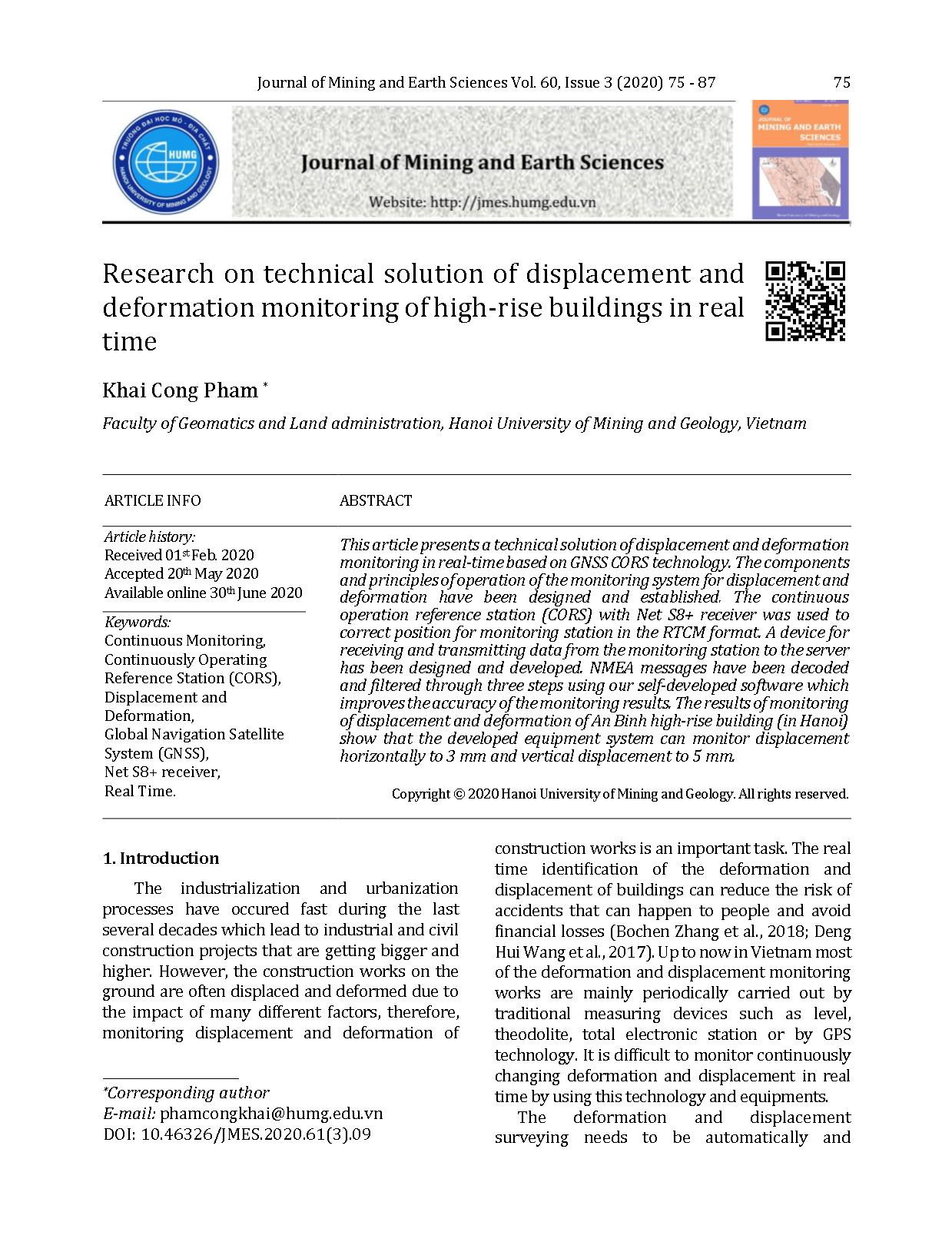
Trang 1
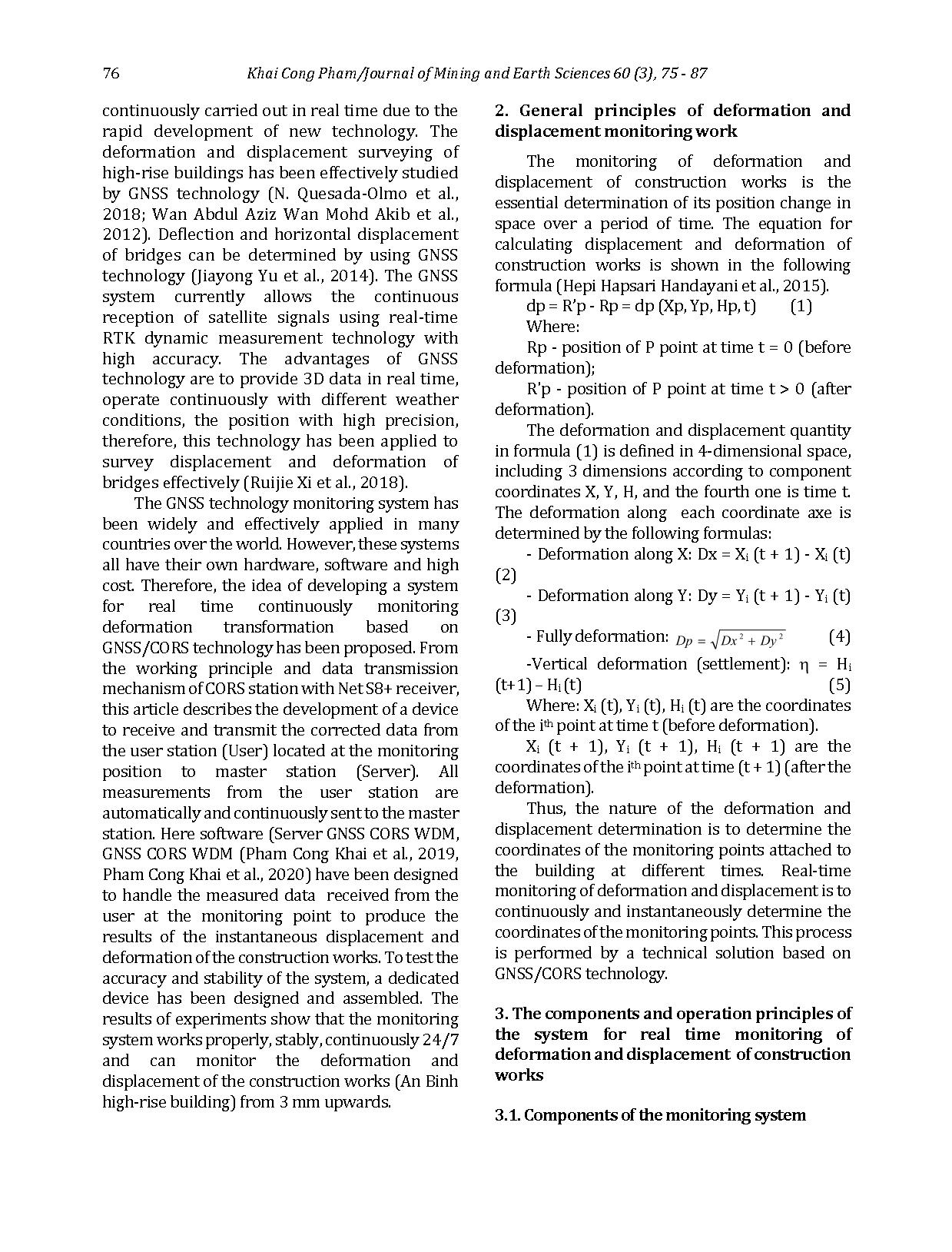
Trang 2
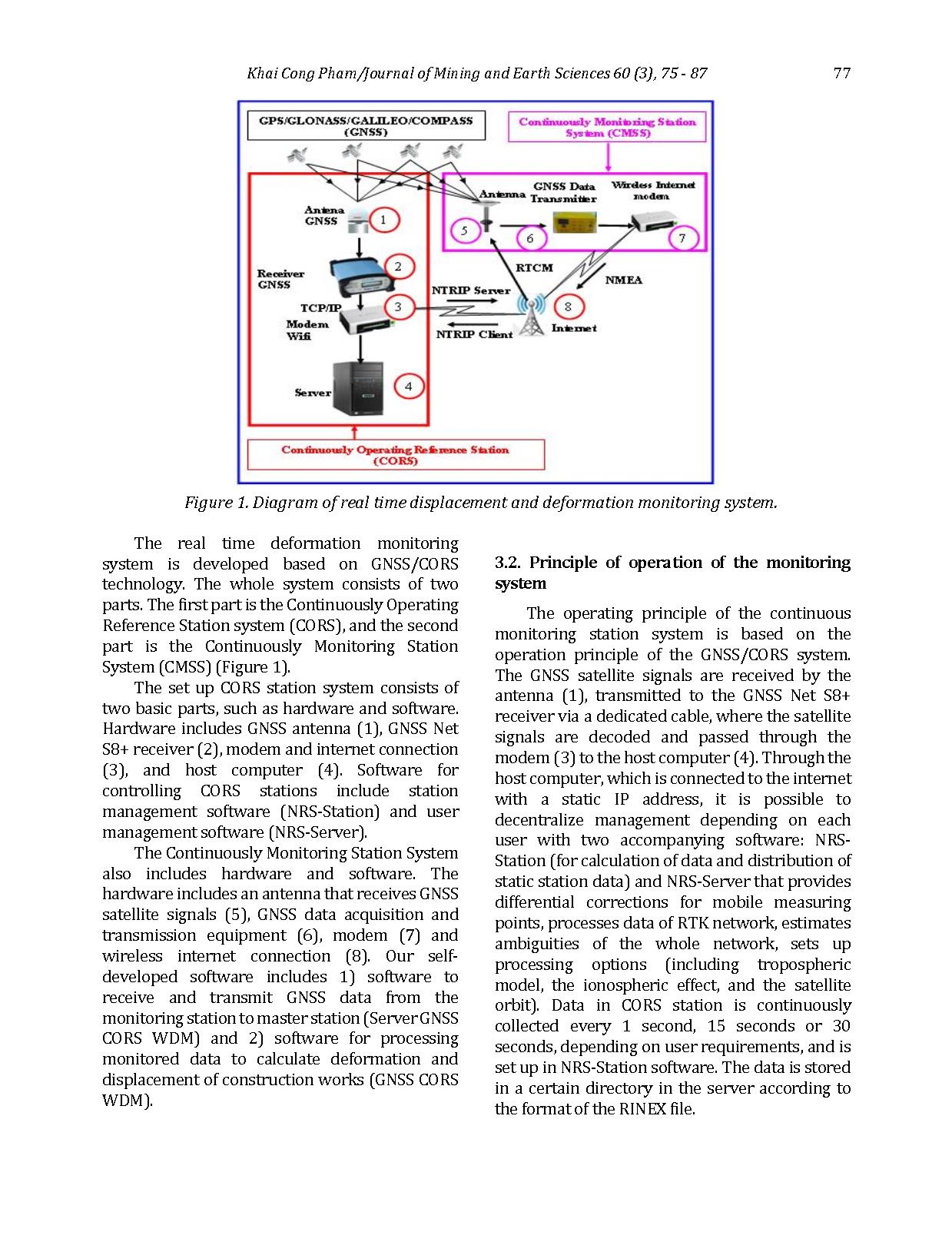
Trang 3
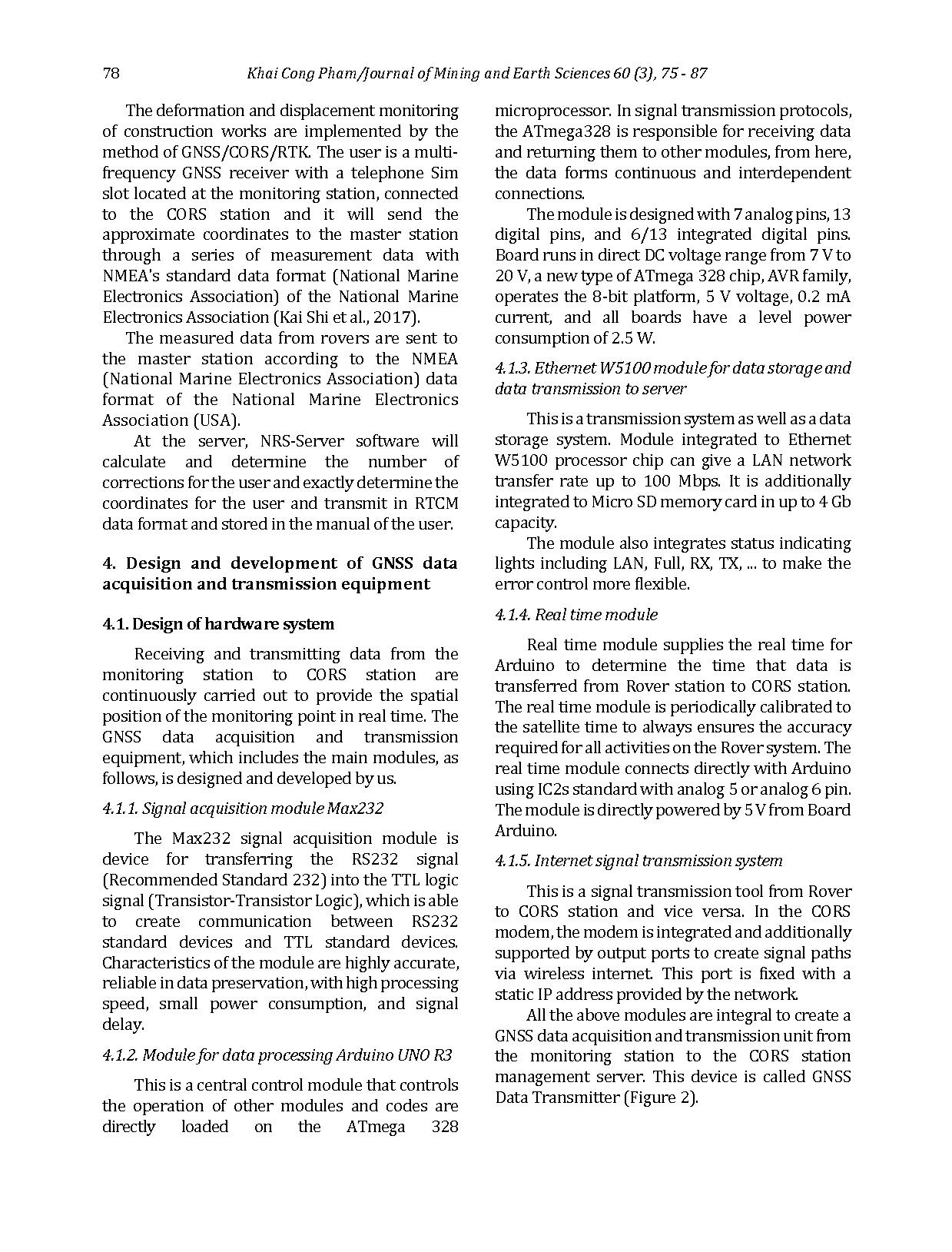
Trang 4
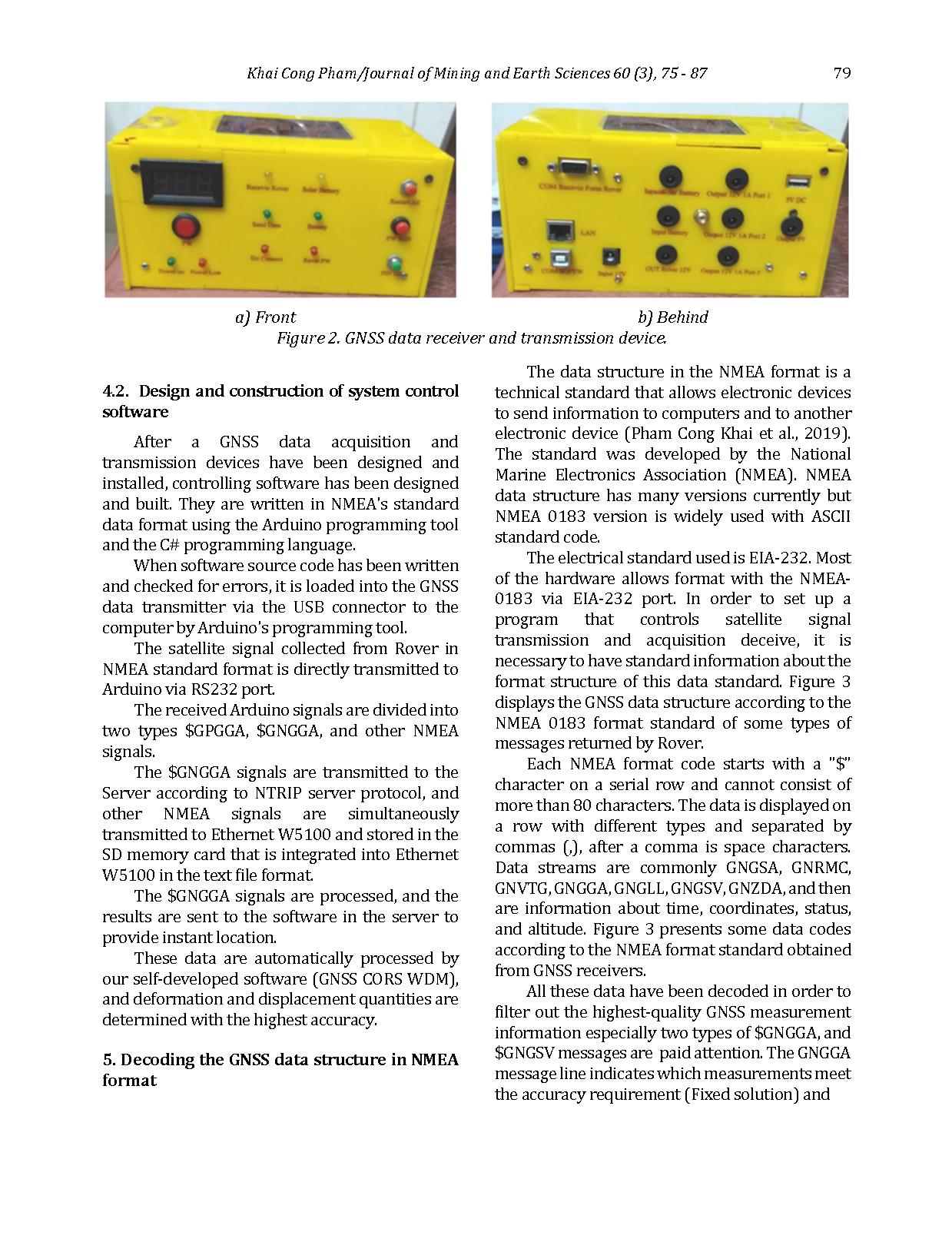
Trang 5
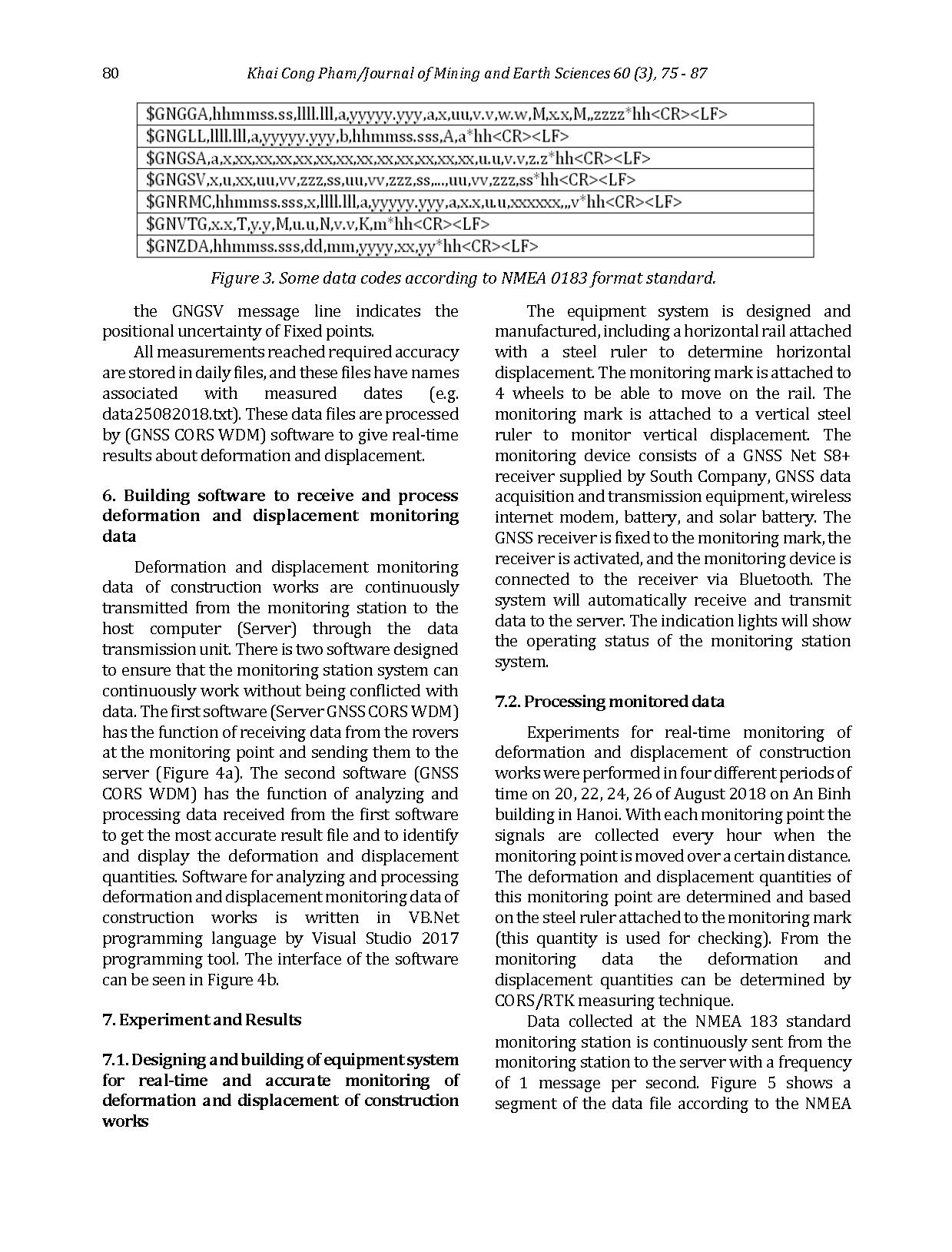
Trang 6
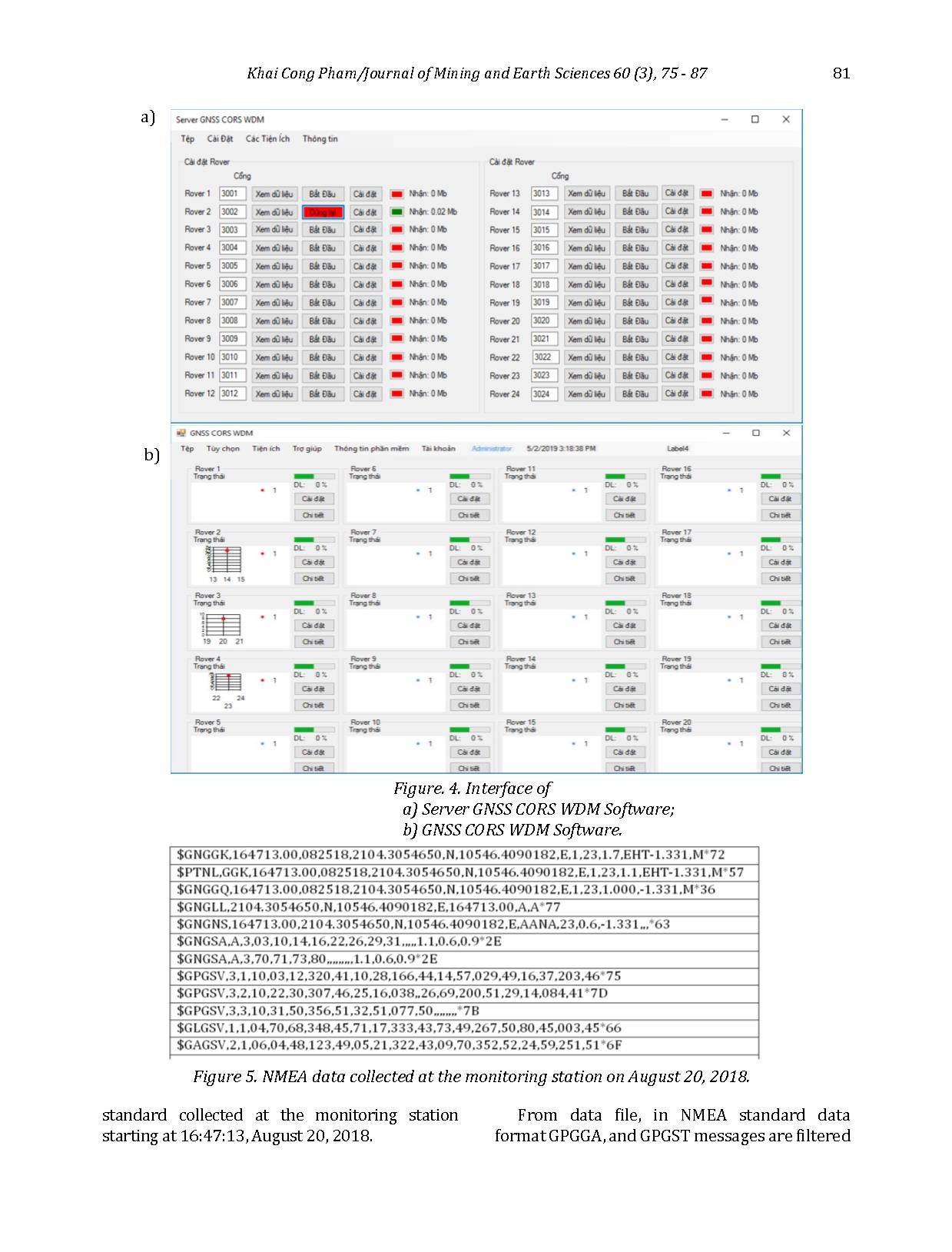
Trang 7
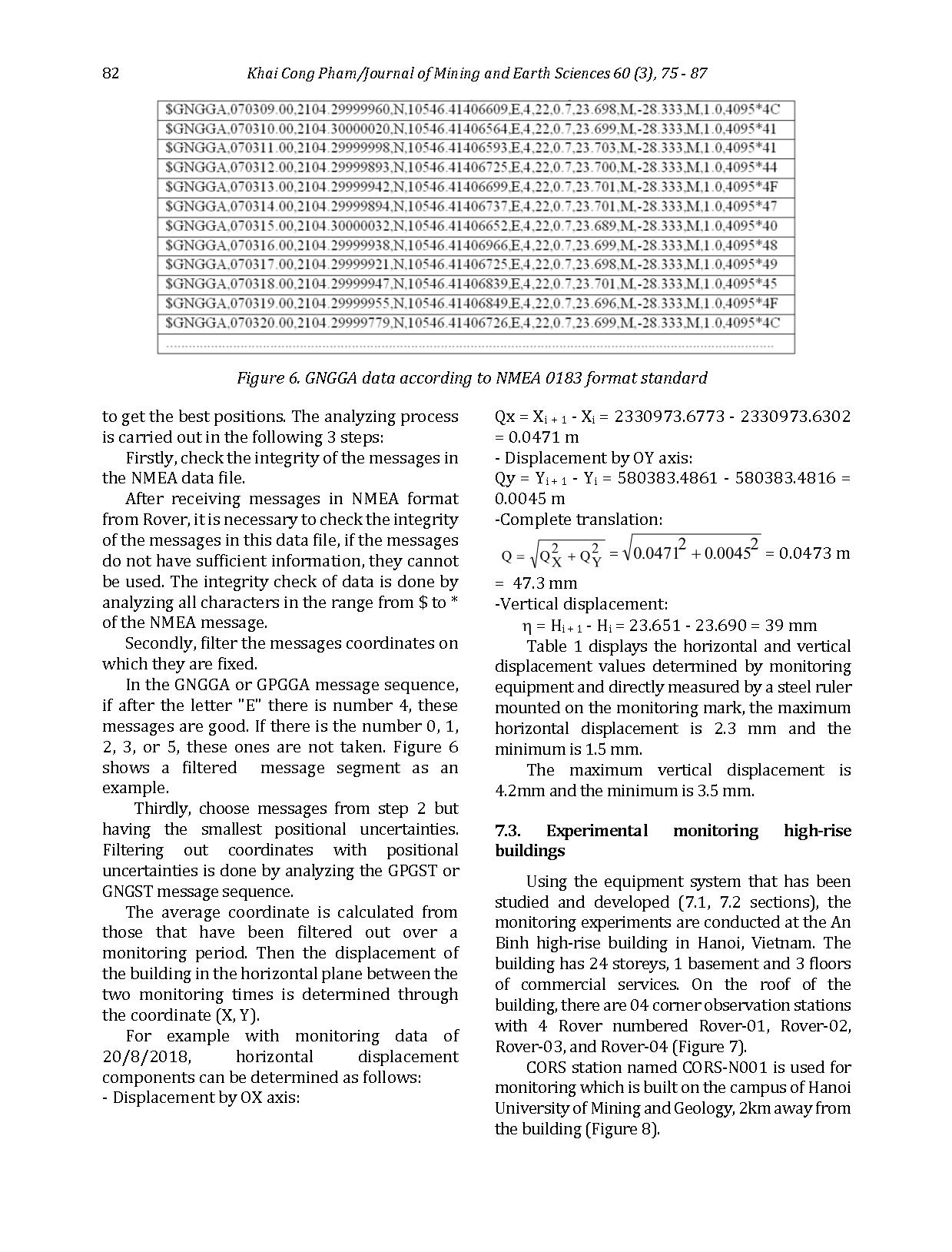
Trang 8
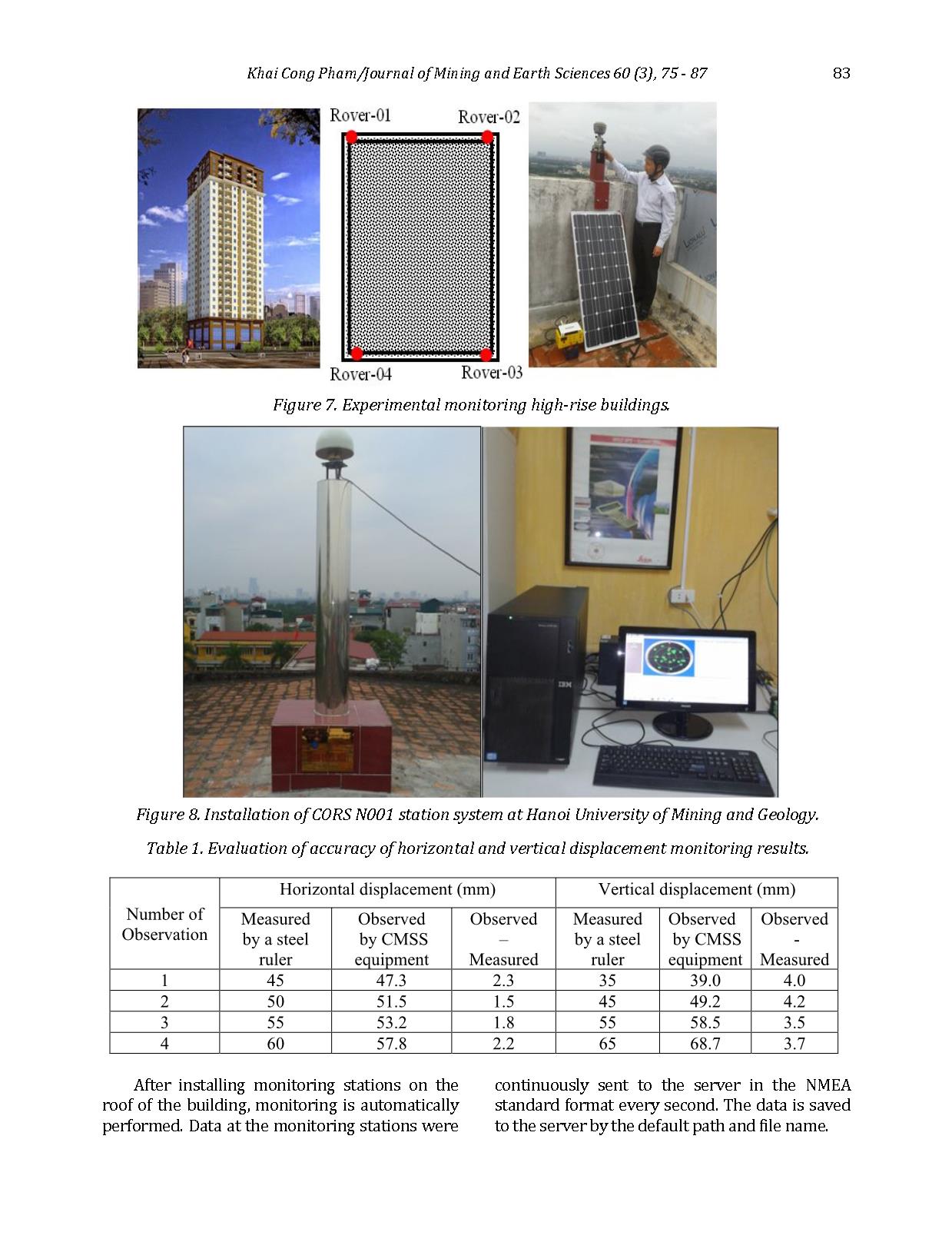
Trang 9
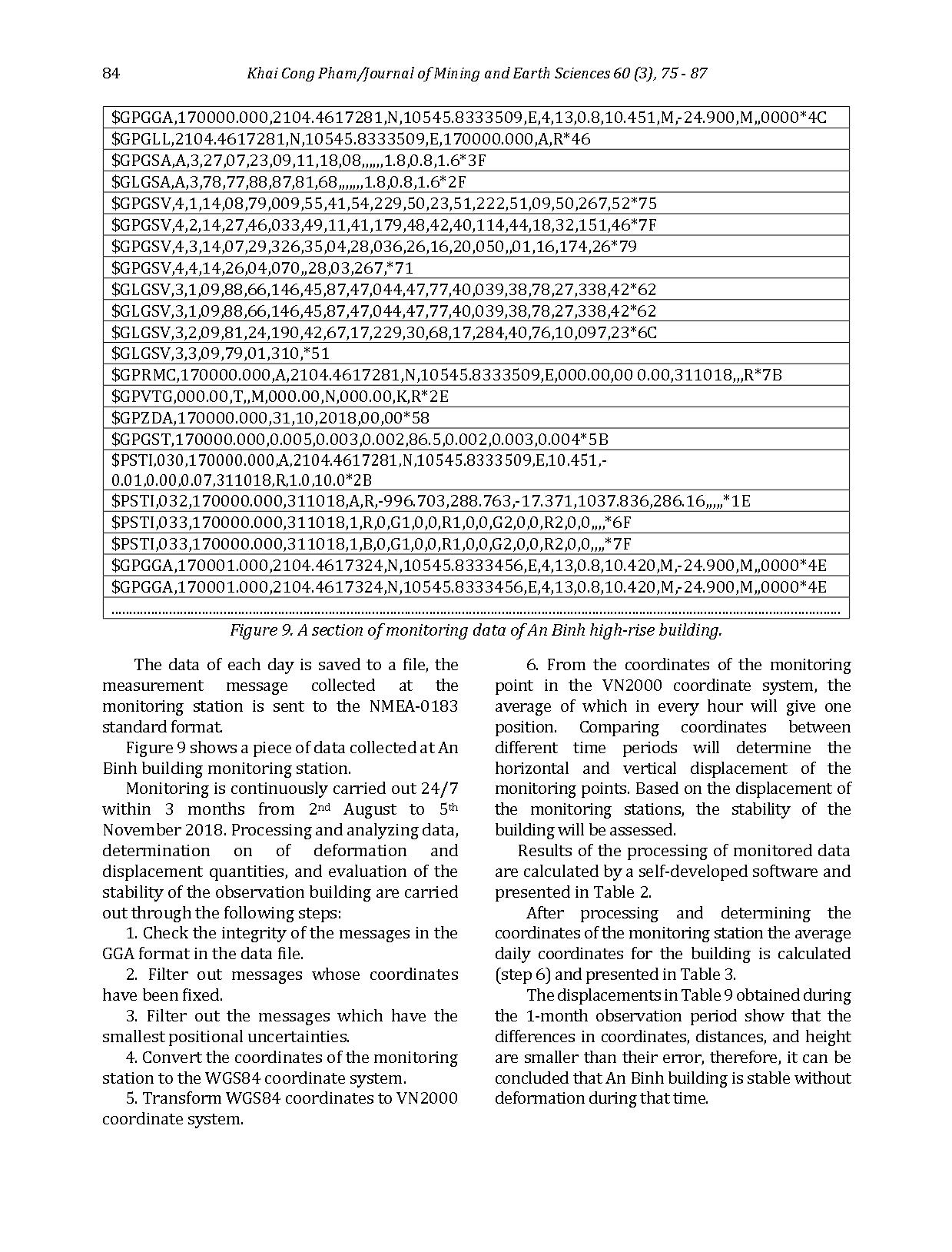
Trang 10
Tải về để xem bản đầy đủ
Tóm tắt nội dung tài liệu: Research on technical solution of displacement and deformation monitoring of high-Rise buildings in real time
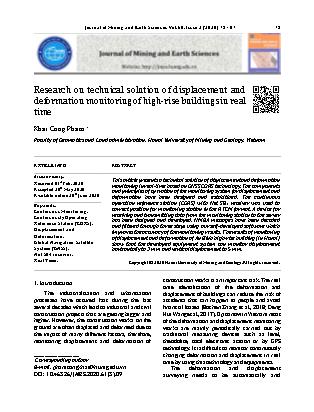
Journal of Mining and Earth Sciences Vol. 60, Issue 3 (2020) 75 - 87 75 Research on technical solution of displacement and deformation monitoring of high-rise buildings in real time Khai Cong Pham * Faculty of Geomatics and Land administration, Hanoi University of Mining and Geology, Vietnam ARTICLE INFO ABSTRACT Article history: Received 01st Feb. 2020 Accepted 20th May 2020 Available online 30th June 2020 This article presents a technical solution of displacement and deformation monitoring in real-time based on GNSS CORS technology. The components and principles of operation of the monitoring system for displacement and deformation have been designed and established. The continuous operation reference station (CORS) with Net S8+ receiver was used to correct position for monitoring station in the RTCM format. A device for receiving and transmitting data from the monitoring station to the server has been designed and developed. NMEA messages have been decoded and filtered through three steps using our self-developed software which improves the accuracy of the monitoring results. The results of monitoring of displacement and deformation of An Binh high-rise building (in Hanoi) show that the developed equipment system can monitor displacement horizontally to 3 mm and vertical displacement to 5 mm. Copyright © 2020 Hanoi University of Mining and Geology. All rights reserved. Keywords: Continuous Monitoring, Continuously Operating Reference Station (CORS), Displacement and Deformation, Global Navigation Satellite System (GNSS), Net S8+ receiver, Real Time. 1. Introduction The industrialization and urbanization processes have occured fast during the last several decades which lead to industrial and civil construction projects that are getting bigger and higher. However, the construction works on the ground are often displaced and deformed due to the impact of many different factors, therefore, monitoring displacement and deformation of construction works is an important task. The real time identification of the deformation and displacement of buildings can reduce the risk of accidents that can happen to people and avoid financial losses (Bochen Zhang et al., 2018; Deng Hui Wang et al., 2017). Up to now in Vietnam most of the deformation and displacement monitoring works are mainly periodically carried out by traditional measuring devices such as level, theodolite, total electronic station or by GPS technology. It is difficult to monitor continuously changing deformation and displacement in real time by using this technology and equipments. The deformation and displacement surveying needs to be automatically and _____________________ *Corresponding author E-mail: phamcongkhai@humg.edu.vn DOI: 10.46326/JMES.2020.61(3).09 76 Khai Cong Pham/Journal of Mining and Earth Sciences 60 (3), 75 - 87 continuously carried out in real time due to the rapid development of new technology. The deformation and displacement surveying of high-rise buildings has been effectively studied by GNSS technology (N. Quesada-Olmo et al., 2018; Wan Abdul Aziz Wan Mohd Akib et al., 2012). Deflection and horizontal displacement of bridges can be determined by using GNSS technology (Jiayong Yu et al., 2014). The GNSS system currently allows the continuous reception of satellite signals using real-time RTK dynamic measurement technology with high accuracy. The advantages of GNSS technology are to provide 3D data in real time, operate continuously with different weather conditions, the position with high precision, therefore, this technology has been applied to survey displacement and deformation of bridges effectively (Ruijie Xi et al., 2018). The GNSS technology monitoring system has been widely and effectively applied in many countries over the world. However, these systems all have their own hardware, software and high cost. Therefore, the idea of developing a system for real time continuously monitoring deformation transformation based on GNSS/CORS technology has been proposed. From the working principle and data transmission mechanism of CORS station with Net S8+ receiver, this article describes the development of a device to receive and transmit the corrected data from the user station (User) located at the monitoring position to master station (Server). All measurements from the user station are automatically and continuously sent to the master station. Here software (Server GNSS CORS WDM, GNSS CORS WDM (Pham Cong Khai et al., 2019, Pham Cong Khai et al., 2020) have been designed to handle the measured data received from the user at the monitoring point to produce the results of the instantaneous displacement and deformation of the construction works. To test the accuracy and stability of the system, a dedicated device has been designed and assembled. The results of experiments show that the monitoring system works properly, stably, continuously 24/7 and can monitor the deformation and displacement of the construction works (An Binh high-rise building) from 3 mm upwards. 2. General principles of deformation and displacement monitoring work The monitoring of deformation and displacement of construction works is the essential determination of its position change in space over a period of time. The equation for calculating displacement and deformation of construction works is shown in the following formula (Hepi Hapsari Handayani et al., 2015). dp = R’p - Rp = dp (Xp, Yp, Hp, t) (1) Where: Rp - position of P point at time t = 0 (before deformation); R'p - position of P point at time t > 0 (after deformation). The deformation and displacement quantity in formula (1) is defined in 4-dimensional space, including 3 dimensions according to component coordinates X, Y, H, and the fourth one is time t. The deformation along each coordinate axe is determined by the following formulas: - Deformation along X: Dx = Xi (t + 1) - Xi (t) (2) - Deformation along Y: Dy = Yi (t + 1) ... by OY axis: Qy = Yi + 1 - Yi = 580383.4861 - 580383.4816 = 0.0045 m -Complete translation: 2YQ2XQQ = 20045.020471.0 = 0.0473 m = 47.3 mm -Vertical displacement: = Hi + 1 - Hi = 23.651 - 23.690 = 39 mm Table 1 displays the horizontal and vertical displacement values determined by monitoring equipment and directly measured by a steel ruler mounted on the monitoring mark, the maximum horizontal displacement is 2.3 mm and the minimum is 1.5 mm. The maximum vertical displacement is 4.2mm and the minimum is 3.5 mm. 7.3. Experimental monitoring high-rise buildings Using the equipment system that has been studied and developed (7.1, 7.2 sections), the monitoring experiments are conducted at the An Binh high-rise building in Hanoi, Vietnam. The building has 24 storeys, 1 basement and 3 floors of commercial services. On the roof of the building, there are 04 corner observation stations with 4 Rover numbered Rover-01, Rover-02, Rover-03, and Rover-04 (Figure 7). CORS station named CORS-N001 is used for monitoring which is built on the campus of Hanoi University of Mining and Geology, 2km away from the building (Figure 8). Figure 6. GNGGA data according to NMEA 0183 format standard Khai Cong Pham/Journal of Mining and Earth Sciences 60 (3), 75 - 87 83 After installing monitoring stations on the roof of the building, monitoring is automatically performed. Data at the monitoring stations were continuously sent to the server in the NMEA standard format every second. The data is saved to the server by the default path and file name. Figure 7. Experimental monitoring high-rise buildings. Number of Observation Horizontal displacement (mm) Vertical displacement (mm) Measured by a steel ruler Observed by CMSS equipment Observed – Measured Measured by a steel ruler Observed by CMSS equipment Observed - Measured 1 45 47.3 2.3 35 39.0 4.0 2 50 51.5 1.5 45 49.2 4.2 3 55 53.2 1.8 55 58.5 3.5 4 60 57.8 2.2 65 68.7 3.7 Table 1. Evaluation of accuracy of horizontal and vertical displacement monitoring results. Figure 8. Installation of CORS N001 station system at Hanoi University of Mining and Geology. 84 Khai Cong Pham/Journal of Mining and Earth Sciences 60 (3), 75 - 87 The data of each day is saved to a file, the measurement message collected at the monitoring station is sent to the NMEA-0183 standard format. Figure 9 shows a piece of data collected at An Binh building monitoring station. Monitoring is continuously carried out 24/7 within 3 months from 2nd August to 5th November 2018. Processing and analyzing data, determination on of deformation and displacement quantities, and evaluation of the stability of the observation building are carried out through the following steps: 1. Check the integrity of the messages in the GGA format in the data file. 2. Filter out messages whose coordinates have been fixed. 3. Filter out the messages which have the smallest positional uncertainties. 4. Convert the coordinates of the monitoring station to the WGS84 coordinate system. 5. Transform WGS84 coordinates to VN2000 coordinate system. 6. From the coordinates of the monitoring point in the VN2000 coordinate system, the average of which in every hour will give one position. Comparing coordinates between different time periods will determine the horizontal and vertical displacement of the monitoring points. Based on the displacement of the monitoring stations, the stability of the building will be assessed. Results of the processing of monitored data are calculated by a self-developed software and presented in Table 2. After processing and determining the coordinates of the monitoring station the average daily coordinates for the building is calculated (step 6) and presented in Table 3. The displacements in Table 9 obtained during the 1-month observation period show that the differences in coordinates, distances, and height are smaller than their error, therefore, it can be concluded that An Binh building is stable without deformation during that time. $GPGGA,170000.000,2104.4617281,N,10545.8333509,E,4,13,0.8,10.451,M,-24.900,M,,0000*4C $GPGLL,2104.4617281,N,10545.8333509,E,170000.000,A,R*46 $GPGSA,A,3,27,07,23,09,11,18,08,,,,,,1.8,0.8,1.6*3F $GLGSA,A,3,78,77,88,87,81,68,,,,,,,1.8,0.8,1.6*2F $GPGSV,4,1,14,08,79,009,55,41,54,229,50,23,51,222,51,09,50,267,52*75 $GPGSV,4,2,14,27,46,033,49,11,41,179,48,42,40,114,44,18,32,151,46*7F $GPGSV,4,3,14,07,29,326,35,04,28,036,26,16,20,050,,01,16,174,26*79 $GPGSV,4,4,14,26,04,070,,28,03,267,*71 $GLGSV,3,1,09,88,66,146,45,87,47,044,47,77,40,039,38,78,27,338,42*62 $GLGSV,3,1,09,88,66,146,45,87,47,044,47,77,40,039,38,78,27,338,42*62 $GLGSV,3,2,09,81,24,190,42,67,17,229,30,68,17,284,40,76,10,097,23*6C $GLGSV,3,3,09,79,01,310,*51 $GPRMC,170000.000,A,2104.4617281,N,10545.8333509,E,000.00,00 0.00,311018,,,R*7B $GPVTG,000.00,T,,M,000.00,N,000.00,K,R*2E $GPZDA,170000.000,31,10,2018,00,00*58 $GPGST,170000.000,0.005,0.003,0.002,86.5,0.002,0.003,0.004*5B $PSTI,030,170000.000,A,2104.4617281,N,10545.8333509,E,10.451,-0.01,0.00,0.07,311018,R,1.0,10.0*2B $PSTI,032,170000.000,311018,A,R,-996.703,288.763,-17.371,1037.836,286.16,,,,,*1E $PSTI,033,170000.000,311018,1,R,0,G1,0,0,R1,0,0,G2,0,0,R2,0,0,,,,*6F $PSTI,033,170000.000,311018,1,B,0,G1,0,0,R1,0,0,G2,0,0,R2,0,0,,,,*7F $GPGGA,170001.000,2104.4617324,N,10545.8333456,E,4,13,0.8,10.420,M,-24.900,M,,0000*4E $GPGGA,170001.000,2104.4617324,N,10545.8333456,E,4,13,0.8,10.420,M,-24.900,M,,0000*4E .......................................................................................................................................................................................................... Figure 9. A section of monitoring data of An Binh high-rise building. Khai Cong Pham/Journal of Mining and Earth Sciences 60 (3), 75 - 87 85 8. Conclusion This work has focused on solving the problem of continuous monitoring deformation and displacement using GNSS/CORS technology. A diagram of the continuous monitoring system has been set up, including the CORS station system and CMSS monitoring station. The message types of the GNSS data structure have been successfully studied and decoded including NMEA format messages sent from the host monitoring station to the server of the CORS station. A GNSS data transmission system has been designed to develop both hardware and software that can in real time, continuously and automatically monitor deformation and displacement of construction works. The developed system automatically works well, stably, and guarantees instantaneous transmission of data from the monitoring station to the host computer. GNSS data processing software designed and developed allows for processing data and immediately determining the deformation and displacement of construction works. The system No B o L o H (m) X (m) Y (m) h (m) 1 21 4 11.158440 105 46 38.154462 68.407 2330873.187 580572.482 93.469 2 21 4 11.158470 105 46 38.154516 68.410 2330873.188 580572.484 93.472 3 21 4 11.158440 105 46 38.154558 68.409 2330873.187 580572.485 93.471 4 21 4 11.158554 105 46 38.154456 68.402 2330873.190 580572.482 93.464 5 21 4 11.158434 105 46 38.154552 68.405 2330873.186 580572.485 93.467 6 21 4 11.158530 105 46 38.154486 68.409 2330873.189 580572.483 93.471 7 21 4 11.158554 105 46 38.154522 68.410 2330873.190 580572.484 93.472 8 21 4 11.158440 105 46 38.154468 68.402 2330873.187 580572.482 93.464 9 21 4 11.158422 105 46 38.154492 68.405 2330873.186 580572.483 93.467 10 21 4 11.158464 105 46 38.154450 68.407 2330873.187 580572.482 93.469 11 21 4 11.158482 105 46 38.154564 68.402 2330873.188 580572.485 93.464 12 21 4 11.158428 105 46 38.154528 68.405 2330873.186 580572.484 93.467 13 21 4 11.158566 105 46 38.154450 68.407 2330873.190 580572.482 93.469 14 21 4 11.158566 105 46 38.154510 68.402 2330873.190 580572.484 93.464 15 21 4 11.158494 105 46 38.154504 68.405 2330873.188 580572.483 93.467 16 21 4 11.158518 105 46 38.154450 68.402 2330873.189 580572.482 93.464 17 21 4 11.158536 105 46 38.154444 68.402 2330873.190 580572.482 93.464 18 21 4 11.158554 105 46 38.154420 68.403 2330873.190 580572.481 93.465 19 21 4 11.158452 105 46 38.154564 68.410 2330873.187 580572.485 93.472 20 21 4 11.158464 105 46 38.154516 68.401 2330873.187 580572.484 93.463 21 21 4 11.158446 105 46 38.154474 68.409 2330873.187 580572.483 93.471 22 21 4 11.158524 105 46 38.154462 68.408 2330873.189 580572.482 93.470 23 21 4 11.158470 105 46 38.154534 68.407 2330873.188 580572.484 93.469 24 21 4 11.158542 105 46 38.154570 68.410 2330873.190 580572.485 93.472 25 21 4 11.158548 105 46 38.154468 68.405 2330873.190 580572.482 93.467 26 21 4 11.158494 105 46 38.154432 68.408 2330873.188 580572.481 93.470 27 21 4 11.158578 105 46 38.154540 68.407 2330873.191 580572.485 93.469 28 21 4 11.158512 105 46 38.154474 68.405 2330873.189 580572.483 93.467 29 21 4 11.158500 105 46 38.154462 68.405 2330873.188 580572.482 93.467 30 21 4 11.158464 105 46 38.154444 68.402 2330873.187 580572.482 93.464 ... ........................ ............................ ........... .................... .................. ............ Table 2. Results of processing of monitored data on step 4, 5 of An Binh high-rise building 86 Khai Cong Pham/Journal of Mining and Earth Sciences 60 (3), 75 - 87 Monitoring time X (m) Y (m) H (m) dX (mm) dY (mm) dP (mm) dh (mm) 2/8/2018 2330873.189 580572.484 93.471 2 3 3.6 -3 3/8/2018 2330873.191 580572.487 93.468 4 2 4.5 3 4/8/2018 2330873.195 580572.489 93.471 -2 -4 4.5 -5 5/8/2018 2330873.193 580572.485 93.466 -4 3 5.0 4 6/8/2018 2330873.189 580572.488 93.47 1 -4 4.1 -2 7/8/2018 2330873.19 580572.484 93.468 -5 -4 6.4 -6 8/8/2018 2330873.185 580572.48 93.462 2 4 4.5 -1 9/8/2018 2330873.187 580572.484 93.461 -1 -3 3.2 2 10/8/2018 2330873.186 580572.481 93.463 5 7 8.6 4 11/8/2018 2330873.191 580572.488 93.467 -2 -1 2.2 3 12/8/2018 2330873.189 580572.487 93.47 3 -3 4.2 1 13/8/2018 2330873.192 580572.484 93.471 2 2 2.8 -5 14/8/2018 2330873.194 580572.486 93.466 -4 -1 4.1 1 15/8/2018 2330873.19 580572.485 93.467 2 4 4.5 2 16/8/2018 2330873.192 580572.489 93.469 3 -4 5.0 -2 17/8/2018 2330873.195 580572.485 93.467 -4 -3 5.0 -1 18/8/2018 2330873.191 580572.482 93.466 -5 2 5.4 5 19/8/2018 2330873.186 580572.484 93.471 4 3 5.0 -2 20/8/2018 2330873.19 580572.487 93.469 2 1 2.2 4 21/8/2018 2330873.192 580572.488 93.473 -1 -4 4.1 -1 22/8/2018 2330873.191 580572.484 93.472 -2 1 2.2 -2 23/8/2018 2330873.189 580572.485 93.47 4 3 5.0 5 24/8/2018 2330873.193 580572.488 93.475 2 -3 3.6 -5 25/8/2018 2330873.195 580572.485 93.47 -6 -3 6.7 1 26/8/2018 2330873.189 580572.482 93.471 6 4 7.2 2 27/8/2018 2330873.195 580572.486 93.473 -3 -2 3.6 -2 29/8/2018 2330873.192 580572.484 93.471 -1 3 3.2 6 29/8/2018 2330873.191 580572.487 93.477 -2 -4 4.5 -5 30/8/2018 2330873.189 580572.483 93.472 4 2 4.5 -4 31/8/2018 2330873.193 580572.485 93.468 Table 3. The displacements of An Binh building during 1 month Khai Cong Pham/Journal of Mining and Earth Sciences 60 (3), 75 - 87 87 of monitoring stations has been studied, developed, and tested by specialized equipment. It works well, stably, continuously and ensuresthe required accuracy to monitor deformation and displacement of the construction works up to 3 mm in horizontal and 5 mm in height. Acknowledgements This research was financially supported by the Hanoi People's Committee (grant number 01C-4/08-2016-3) and the Hanoi Department of Science and Technology. References Bochen Zhang, Xiaoli Ding, Charles Werner, Kai Tan, Bin Zhang, Mi Jiang, Jingwen Zhao, Youlin Xu, 2018. Dynamic displacement monitoring of long-span bridges with a microwave radar interferometer. ISPRS Journal of Photogrammetry and Remote Sensing, 138, 252-264. Deng hui Wang, Xiaolin Meng, Chengfa Gao, Shuguo Pan, Qusen Chen, 2017. Multipath extraction and mitigation for bridge deformation monitoring using a single-difference model. Advances in Space Research, 60, Issue 12, 2882-2895. Hepi Hapsari Handayani, Yuwono, Taufik M, 2015. Preliminary study of bridge deformation monitoring using GPS and CRP (case study: Suramadu Bridge). Procedia Environmental Sciences, 24, 266-276. Jiayong Yu, Xiaolin Meng, Xudong Shao, Banfu Yan, Lei Yang, 2014. Identification of dynamic displacements and modal frequencies of a medium-span suspension bridge using multimode GNSS processing. Engineering Structures, 81, 432-443. N. Quesada-Olmo, M.J. Jimenez-Martinez, M. Farjas-Abadia, 2018. Real-time high-rise building monitoring system using global navigation satellite system technology. Measurement, 123, 115-124. Ruijie Xi, Weiping Jiang, Xiaolin Meng, Hua Chen, Qusen Chen, 2018. Bridge monitoring using BDS-RTK and GPS-RTK techniques. Measurement, 120, 128-139. Wan Abdul Aziz Wan Mohd Akib, Shu Kian Kok, Zulkarnaini Mat Amin, 2012. High Rise Building Deformation Monitoring With GPS. Department of Geomatic Enginnering Faculty of Geoinformation Science & Engineering University Teknologi Malaysia, 81310 Skudai, Johor Malaysia. Kai Shi, Ming Xu, Haoxia Jin, Tong Qiao, XueYang, Ning Zheng, JianXu, Kim-Kwang Raymond Choo, 2017. A novel file carving algorithm for National Marine Electronics Association (NMEA) logs in GPS forensics. Digital Investigation, 23, 11-21. Pham Cong Khai, Le Van Canh, Nguyen Quoc Long, Nguyen Viet Nghia, Pham Van Chung, Vo Ngoc Dung, Nguyen Gia Trong, Le Duc Tinh, Nguyen Viet Ha, Nguyen Van Sang, 2019. Research on technology applycation continous monitoring of displacement and deformation of works in erea of Hanoi City. Final report of Science and Technology project of city level. Grant number 01C-04/08-2016-3. Hanoi Department of Science and Technology. Pham Cong Khai, Nguyen Van Hai, (2020). Investigation and design of monitoring systems in real time landslides at Xekaman 3 hydropower plant. Journal of Mining and Earth Sciences 61 (1), 11-20.
File đính kèm:
 research_on_technical_solution_of_displacement_and_deformati.pdf
research_on_technical_solution_of_displacement_and_deformati.pdf

